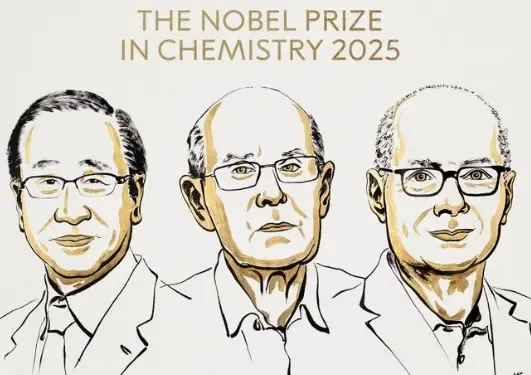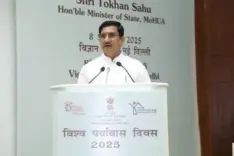Who Are the 2025 Chemistry Nobel Laureates?

Synopsis
Key Takeaways
- Susumu Kitagawa, Richard Robson, and Omar M. Yaghi received the 2025 Nobel Prize in Chemistry.
- Their work focuses on metal-organic frameworks (MOFs) that enhance gas and chemical flow.
- MOFs have applications in water harvesting and carbon capture.
- Their research began in 1989 and has led to thousands of unique MOFs.
- These advancements could help tackle major global challenges.
New Delhi, Oct 8 (NationPress) On Wednesday, scientists Susumu Kitagawa, Richard Robson, and Omar M. Yaghi received the prestigious 2025 Nobel Prize in Chemistry for their innovative work in creating molecular structures with large cavities that facilitate the flow of gases and other chemicals.
These structures, known as metal-organic frameworks, have been utilized for various applications such as extracting water from the arid atmosphere, capturing carbon dioxide, storing harmful gases, and catalyzing chemical reactions.
Kitagawa, a professor at Kyoto University in Japan; Robson, a professor at the University of Melbourne in Australia; and Yaghi, a professor at the University of California, Berkeley, USA, were honored for their contributions to the field.
During the Nobel press conference, Kitagawa expressed his profound gratitude for the recognition, stating, "My aspiration is to harness air and segregate its components—like CO2, oxygen, or water—and transform them into useful materials using renewable energy." The 74-year-old professor emphasized the significance of challenges in science and chemistry.
Yaghi, a Jordanian-American who grew up in a modest home with Palestinian refugees, shared his remarkable journey: "It's a significant path, and science enables you to traverse it." He recounted how his parents had minimal education, asserting, "Science is the ultimate equalizer in society." At 60 years old, Yaghi expressed his excitement and amazement at receiving the award.
His fascination with chemistry began at the age of 10 when he discovered a book about molecules, igniting a passion that has lasted a lifetime. "I aimed to create beautiful constructs and tackle intellectual challenges. The deeper you explore, the more elegantly you discover the intricacies of construction," he conveyed during the press event.
The research initiative, which began in 1989 with Robson, a chemist originally from Britain, was inspired by the structure of diamonds. Robson, now 88, combined copper ions with a four-armed molecule to create pyramid-like structures that interlinked to form crystals filled with cavities.
Although Robson recognized the potential of these structures, they were initially unstable and prone to collapse. The subsequent research by Kitagawa and Yaghi transformed these metal-organic frameworks into valuable materials.
Heiner Linke, Chair of the Nobel Committee for Chemistry, stated, "Metal-organic frameworks hold tremendous potential, unlocking unexpected opportunities for customized materials with innovative functions." In light of the laureates' groundbreaking work, chemists have developed thousands of unique MOFs.
These advancements may play a crucial role in addressing some of humanity's most pressing issues, including purifying water by removing PFAS, breaking down environmental pharmaceutical residues, capturing carbon dioxide, and harvesting water from desert climates.









